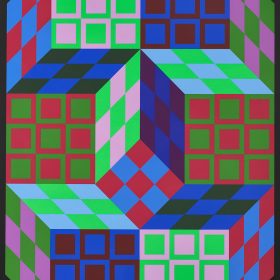
Victor Vasarely was a French-Hungarian artist credited as the grandfather and leader of the Op Art movement. In the late 1920s, he enrolled at the Muhely Academy in Budapest, where the curriculum was largely based on Walter Gropius’s Bauhaus school in Germany. Vasarely’s method of painting drew from a range of influences, including Bauhaus design principles, Wassily Kandinsky, and Constructivism. In 1930, Vasarely settled in Paris. His work is characterised by the use of geometric shapes and colourful graphics, creating compelling illusions of spatial depth.

Born in Lewisham, London, Joe Tilson was one of the great figures in post-war British art and a pivotal artist of the British Pop Art movement during the 1960s. Tilson taught at St Martin’s School of Art from 1958 to 1963 and later taught at several other institutions, including the Slade School of Fine Art, University College London, and the School of Visual Arts in New York. His first one-man shows were held at the Marlborough Gallery, London in 1962 and at the Walker Art Gallery, Liverpool in 1963, and his work gained international recognition at the Venice Biennale. Tilson was elected Royal Academician in 1991 and his work is represented in public and private collections worldwide.

Frank Philip Stella was an American painter, sculptor, and printmaker, noted for his work in the areas of minimalism and post-painterly abstraction. For much of his career, he lived and worked in New York City before relocating his studio to Rock Tavern, New York. Stella played a pivotal role in catalysing the minimalist movement in the late 1950s.
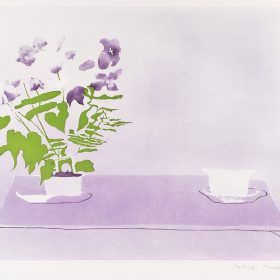
Patrick Procktor was a painter and printmaker born in Dublin in 1936, raised in London. He held his first one-man show at The Redfern Gallery in London’s Cork Street in 1963—a sellout solo exhibition that helped confirm his reputation among a wider artistic circle. Procktor was a keen and highly competent watercolourist and travel-painter. His work was varied in subject—including landscapes, townscapes, figure compositions, portraits, and interiors—and was frequently based on his extensive travels. He died on August 29, 2003, in London. Today, the artist’s works are held in the collections of the Fitzwilliam Museum in Cambridge and the Royal Academy of Arts in London.

Dublin-born printmaker Tim Mara pursued his artistic education at Wolverhampton Art College and the Royal College of Art, London, where he later became Professor of Printmaking and Head of the School of Fine Art. Renowned for his exceptional technical skill, Mara exhibited in over 80 group shows across the UK and more than 50 international exhibitions, including a solo show at the Irish Museum of Modern Art (IMMA) in 2000. His work is featured in public collections worldwide.
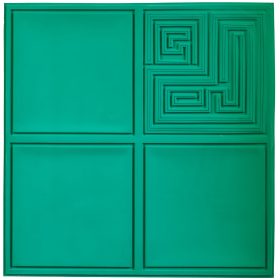
Gordon House studied at Luton School of Art in Bedfordshire and St. Albans School of Art in Hertfordshire before moving into a career in graphic design. From the late 1950s onward, House began producing large-scale abstract works. However, it was in the 1960s that his reputation began to grow: he had become established among a new generation of artists as an independently minded and adventurous painter and designer. He worked for The Beatles, designing their White album and the back of the Sergeant Pepper album, for which his longtime friend Peter Blake designed the front. Later, he designed Wings’ first album cover. His paintings and prints are held in public collections internationally
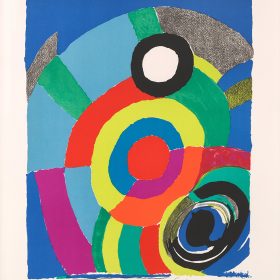
Sonia Delaunay, a French artist born to Jewish parents, is renowned for her vibrant use of colourful geometric patterns. She studied drawing at the Karlsruhe Academy of Fine Arts in Germany before moving to Paris in 1906. In Paris, her painting style evolved, embracing the vivid colours of Fauvism. Along with her husband, Robert Delaunay, pioneered a fusion of Cubism and Neo-Impressionism, a style later named Orphism by poet Guillaume Apollinaire. Throughout her career, Delaunay applied this new aesthetic to her paintings, textiles, and designs and in 1964 she made history as the first living female artist to have a retrospective at the Louvre.
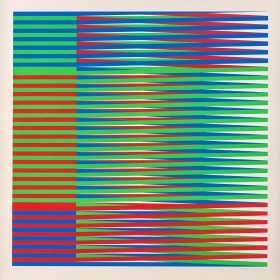
I want people to realise that colour is not a certainty, but a circumstance, he said in 2014. Red is maybe red. It’s not the same if you hold an object under the sun as when you hold it in the shade.
Carlos Cruz-Diez was a Venezuelan artist who is considered one of the greatest artistic innovators of the 20th century. Cruz-Diez harboured a seven-decade obsession that the common understanding of colour was wrong. Colour, the Venezuelan-born artist believed, evolves continuously in time and space.
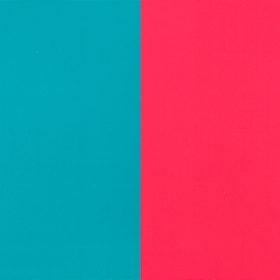
Sir Michael Craig-Martin is an Irish-born conceptual artist and painter, recognised for his influence on the Young British Artists, many of whom he mentored during his teaching career at Goldsmiths where he is now an emeritus Professor of Fine Art. In 2015, he published his memoir and guide for aspiring artists, On Being An Artist. In 2016 he was knighted in the Queen’s Birthday Honours for his services to art. His work is featured in numerous public collections, and will be the subject of a major solo exhibition at the Royal Academy, London from September – December 2024.
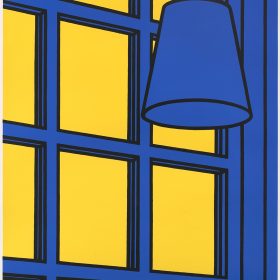
For many he is an artist whose name has now become synonymous with depictions of modern interiors. From dramatizing sunlight as it tilts through windows, or celebrating the formal beauty of everyday objects, Caulfield creates endlessly beguiling images that cross-examine the spaces we inhabit.
Patrick Joseph Caulfield was an English painter and printmaker renowned for bold imagery. He was born in West London in 1936, and from 1956 to 1960, he studied at Chelsea School of Art where he won prizes that funded a working trip to Greece and Crete. Caulfield taught at Chelsea School of Art from 1963 to 1971. In 1964, he exhibited at the New Generation show at London’s Whitechapel Gallery, which led to his association with the Pop Art movement.
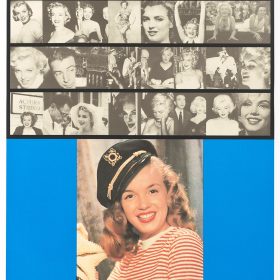
Sir Peter Thomas Blake CBE RDI RA is an English Pop artist, renowned for his interest in the imagery of popular culture. His distinctive work has been central to the British Pop Art movement. He was knighted in 2002 for his contributions to the arts.
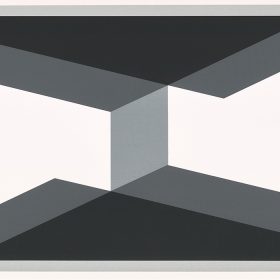
osef Albers, a German-born American artist, was a leading figure in 20th-century art education. He enrolled at the Weimar Bauhaus in 1920 as a student before transitioning to a teaching role in 1922, focusing on handicrafts. Albers emigrated to the United States in 1933, where he had a profound influence on post-war Western visual art. His 1963 book Interaction of Colour remains a foundational text on colour theory. As an abstract painter he is most renowned for his Homage to the Square series, where he meticulously explored colour interactions through nested squares. In 1971, he made history as the first living artist to be honoured with a solo exhibition at the Metropolitan Museum of Art in New York

Alistair Grant was born on June 3rd 1925 in West Kensington, London. He studied at Birmingham College of Art from 1941-43 where he was taught still-life drawing and painting by Fleetwood-Walker. He was then conscripted into the Royal Air Force and trained as Aircrew flying Wellingtons and then Liberators. After The War he was accepted to the Royal College of Art.
During his lifetime as a painter, printmaker, and Professor, Grant was an integral part of the artistic and printmaking life in London. For thirty-five years Alistair Grant and printmaking at the Royal College of Art in London were indivisible. Grant was an inspirational teacher and artist who taught many of his peers.
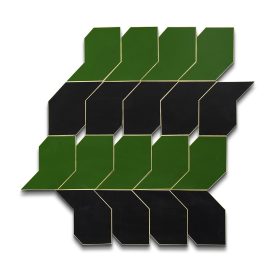
Barbara Freeman is an artist known for her work as a painter, printmaker, sculptor, installation artist, and educator. Born in London, she pursued her artistic education at St Martin’s, Camberwell, and Hammersmith Colleges of Art, earning her diploma in 1962. She later completed a postgraduate diploma at the University of Leeds in 1972. She has taught part-time in several colleges. Though initially focused on sculpture, Freeman transitioned to painting and printmaking in 1982, incorporating mixed media into her practice. Her extensive travels have deeply influenced her work, which spans both figurative and abstract styles. Her art is characterized by a rich, vibrant palette. Freeman has exhibited extensively across the UK, Europe and USA.